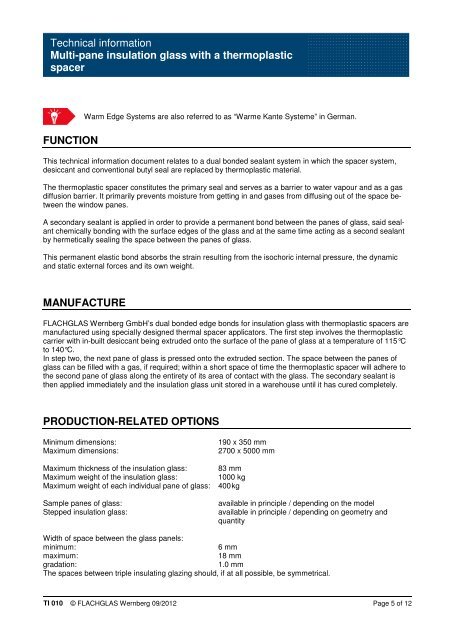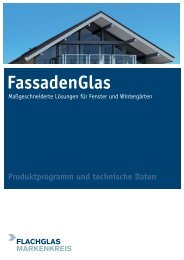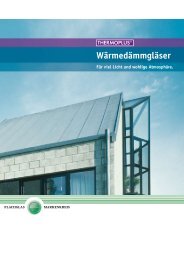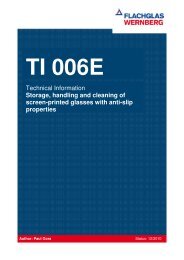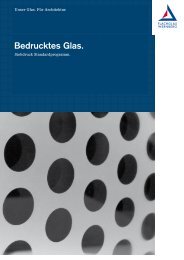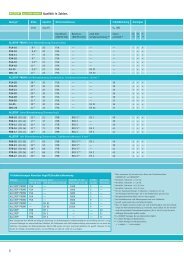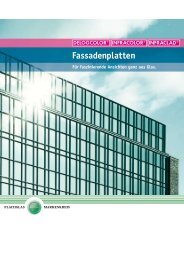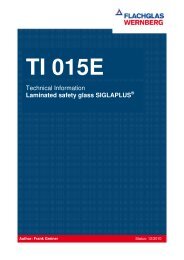TI 010 Insulated glazing with thermoplastic spacer - FLACHGLAS ...
TI 010 Insulated glazing with thermoplastic spacer - FLACHGLAS ...
TI 010 Insulated glazing with thermoplastic spacer - FLACHGLAS ...
You also want an ePaper? Increase the reach of your titles
YUMPU automatically turns print PDFs into web optimized ePapers that Google loves.
Technical informationMulti-pane insulation glass <strong>with</strong> a <strong>thermoplastic</strong><strong>spacer</strong>FUNC<strong>TI</strong>ONWarm Edge Systems are also referred to as “Warme Kante Systeme” in German.This technical information document relates to a dual bonded sealant system in which the <strong>spacer</strong> system,desiccant and conventional butyl seal are replaced by <strong>thermoplastic</strong> material.The <strong>thermoplastic</strong> <strong>spacer</strong> constitutes the primary seal and serves as a barrier to water vapour and as a gasdiffusion barrier. It primarily prevents moisture from getting in and gases from diffusing out of the space betweenthe window panes.A secondary sealant is applied in order to provide a permanent bond between the panes of glass, said sealantchemically bonding <strong>with</strong> the surface edges of the glass and at the same time acting as a second sealantby hermetically sealing the space between the panes of glass.This permanent elastic bond absorbs the strain resulting from the isochoric internal pressure, the dynamicand static external forces and its own weight.MANUFACTURE<strong>FLACHGLAS</strong> Wernberg GmbH’s dual bonded edge bonds for insulation glass <strong>with</strong> <strong>thermoplastic</strong> <strong>spacer</strong>s aremanufactured using specially designed thermal <strong>spacer</strong> applicators. The first step involves the <strong>thermoplastic</strong>carrier <strong>with</strong> in-built desiccant being extruded onto the surface of the pane of glass at a temperature of 115°Cto 140°C.In step two, the next pane of glass is pressed onto the extruded section. The space between the panes ofglass can be filled <strong>with</strong> a gas, if required; <strong>with</strong>in a short space of time the <strong>thermoplastic</strong> <strong>spacer</strong> will adhere tothe second pane of glass along the entirety of its area of contact <strong>with</strong> the glass. The secondary sealant isthen applied immediately and the insulation glass unit stored in a warehouse until it has cured completely.PRODUC<strong>TI</strong>ON-RELATED OP<strong>TI</strong>ONSMinimum dimensions:Maximum dimensions:190 x 350 mm2700 x 5000 mmMaximum thickness of the insulation glass: 83 mmMaximum weight of the insulation glass: 1000 kgMaximum weight of each individual pane of glass: 400 kgSample panes of glass:Stepped insulation glass:available in principle / depending on the modelavailable in principle / depending on geometry andquantityWidth of space between the glass panels:minimum:6 mmmaximum:18 mmgradation:1.0 mmThe spaces between triple insulating <strong>glazing</strong> should, if at all possible, be symmetrical.<strong>TI</strong> <strong>010</strong> © <strong>FLACHGLAS</strong> Wernberg 09/2012 Page 5 of 12


